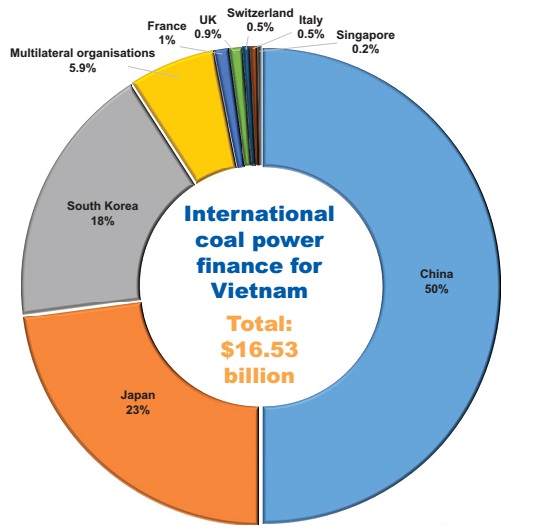China funds coal away from home
 |
| Source: GreenID, Graph: Ngoc Bich |
Nguy Thi Khanh, executive director and founder of the Green Innovation and Development Centre (GreenID), a Vietnamese non-profit promoting sustainable energy sector development, told VIR that China is playing a very substantial role in coal finance in Vietnam via its commercial banks – Industrial and Commercial Bank of China, Bank of China, and China Construction Bank.
“China is the biggest investor in coal-fired power plants in Vietnam, accounting for 50 per cent of Vietnam’s total foreign coal finance funded by nations, followed by Japan (23 per cent) and South Korea (18 per cent),” Khanh said. “While most developed nations and international organisations have stopped coal finance for Vietnam, and with the country in critical need of capital for developing energy – including coal-fired power – China stands ready to increase its coal finance to Vietnam. So Chinese investment capital is very necessary for the country.”
A GreenID report on coal finance in Vietnam released this month showed that China has invested $8.6 billion into implementing coal-fired projects in Vietnam.
Total foreign investment into these projects in Vietnam stands at around $20.5 billion to date, including $4.5 billion from individual foreign investors, and $16 billion from 23 international financial and multilateral organisations (see chart).
Chinese engineering, procurement, and construction (EPC) firms have, through these bank loans, built 15 operating coal-fired thermal power plants – An Khanh 1, Cao Ngan, Cam Pha 1 and 2, Duyen Hai 1 and 3, Haiphong 1 and 2, Mao Khe, Quang Ninh 1 and 2, Son Dong, the Uong Bi extension, Vinh Tan 2, and Vung Ang 1.
At present, Chinese firms are partaking in the construction of other six plants – Hai Duong, Duyen Hai 2 and 3, Thai Binh 2, Thang Long, and Vinh Tan 1. They are also planning to join the construction of Vinh Tan 3 and Vung Ang 3.
The 1,200-megawatt Hai Duong Thermal Power Plant, located in the northern province of Hai Duong, is being built by China’s Southwest Electric Power Design Institute and China Power Engineering Consulting Group International Engineering Co., Ltd. The build-operate-transfer project is China’s biggest private investment of this type in Vietnam.
Currently, China’s Sunshine Kaidi New Energy Group is working with Vietnam’s Ministry of Industry and Trade and several localities on plans to build thermal power plants in the country.
Kaidi, China’s Huarong Asset Management Co., Ltd., and a Vietnamese firm have established an international investment fund with a capital volume of $15 billion dedicated to building projects in Vietnam.
Tran Van Quang, a senior energy expert from one of the largest foreign fund management groups in Vietnam, told VIR that international institutions like the World Bank, IFC, European Investment Bank, and KfW currently refuse to provide coal finance to the country due to concerns about environmental pollution.
“China often provides loans for Vietnam to develop coal-fired power plants via bilateral agreements, and via providing loans for Chinese investors to implement these projects in Vietnam,” Quang said. “I think China’s loans have many purposes, including financial investment, expansion of overseas markets for Chinese state-owned companies, and export of used technologies and equipment to those markets.”
According to GreenID, as part of years-long effort to shift to cleaner fuel, China recently postponed the domestic construction of 30 large-scale coal-fired power plants, with a total capacity of 17 gigawatts. A further 30 projects have been cancelled outright, following a national roadmap to reduce coal dependency.
While reducing coal power at home, Chinese state-owned companies and banks are expanding coal investment in developing countries, especially in Asia, GreenID said.
According to the recent report, “Slowing the growth of coal power outside China: The role of Chinese finance” by San Francisco-based Climate Policy Initiative, most Chinese coal power financing has been going towards South Asia and Southeast Asia, with three countries – India, Indonesia, and Vietnam – representing around 60 per cent of the total.
China’s engagement in the overseas coal power sector has helped Chinese companies alleviate domestic industrial overcapacity; find markets and opportunities for Chinese products, services, and investments; and generate additional profits. For the Chinese government, promoting overseas coal power development also helps it to strengthen strategic political ties and increase its sphere of influence.
“Because of these benefits, China has continued to support overseas coal power through debt finance and, increasingly, through equity investments,” the report concludes.
What the stars mean:
★ Poor ★ ★ Promising ★★★ Good ★★★★ Very good ★★★★★ Exceptional
Latest News
More News
- EVN launches major power infrastructure projects nationwide (December 19, 2025 | 18:17)
- VAL inaugurates second production line to meet domestic animal feed demand (December 19, 2025 | 16:37)
- Sun Group pioneers urban tram system in Phu Quoc (December 19, 2025 | 15:00)
- Seven major projects launched to drive Hanoi’s next growth phase (December 19, 2025 | 14:00)
- Securing capital and efficiency for Vietnam’s 2026-2030 growth ambitions (December 17, 2025 | 10:00)
- Vietnam bucking trend in the global M&A landscape (December 16, 2025 | 14:20)
- HDS Summit spotlights Vietnam’s rising role in regional supply chains (December 16, 2025 | 08:00)
- Kolon signs $48 million airbag supply deal with Autoliv (December 15, 2025 | 18:14)
- National Assembly approves Vinh–Thanh Thuy expressway project (December 15, 2025 | 18:02)
- Quang Tri green-lights $1.59 billion LNG-fired power project (December 15, 2025 | 17:59)


















 Mobile Version
Mobile Version